Product:
DN2.828-04
14 bit digitizer and 16 bit AWG
Description:
The hybridNETBOX DN2.82x series internally consists of a Digitizer and an AWG that can run together or independently. That allows simultaneous data generation and data acquisition for stimulus-response tests, ATE applications, MIMO applications or closed-loop applications. Used independently, the digitizer can acquire test data in the field and the AWG can replay this test data in lab. The hybridNETBOX offers 14/16 bit resolution and is available with digitizer sampling rates of up to 500 MS/s and AWG sampling rates of up to 1.25 GS/s. The hybridNETBOX can be installed anywhere in the company LAN and can be remotely controlled from a host PC.
Facts & Features:
- 4 channel 400 MS/s Digitizer
- 4 channel 625 MS/s AWG
- AWG: Output level ±5 V into High Impedance
- AWG: Output level ±2.5 V into 50 Ohm
- Digitizer and AWG in one Instrument
- 2 GSample acqusition and 2 GSample AWG memory
- Digitizer: separate ADC and amplifier per channel
- Digitizer: 6 input ranges: ±200 mV up to ±10 V
- Digitizer: programmable input offset of ±100%
- Streaming, Multiple Recording, Gated Sampling
- Timestamps, Sequence Replay
- GBit Ethernet/LXI compatible instrument
- Easy connectivity with BNC/SMA connections
- SBench 6 Professional included
- Direct remote access from Workstations or Laptops
- Simple integration into the factory LAN
Application examples:
- Stimulus-Response
- Recorder/Replay
- Automated Test
- Component Test
- MIMO

The ABA mode combines slow continuous data recording with fast acquisition on trigger events. The ABA mode works like a slow data logger combined with a fast digitizer. The exact position of the trigger events is stored as timestamps in an extra memory.

FIFO mode
The FIFO mode is designed for continuous data transfer between the digitizerNETBOX and the host PC. The transfer speed is depending on the Ethernet connection between box and host and is in the region of 40 MB/s to 60 MB/s. The control of the data stream is done automatically by the driver on interrupt request. The complete installed on-board memory is used for buffer data, making the continuous streaming extremely reliable.

Channel Trigger
The data acquisition boards offer a wide variety of trigger modes. Besides the standard signal checking for level and edge as known from oscilloscopes it's also possible to define a window trigger. Trigger conditions can be combined with logical conjunctions like OR to adopt to different application scenarios.
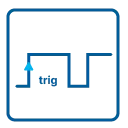
External Trigger
All boards can be triggered using a separate external trigger signal with a two level programmable window comparator and a second separate external trigger with a single programmable level comparator. It's possible to use positive or negative edge. An internally recognized trigger event can - when activated by software - be routed to a multi purpose i/o connector to start external instruments.
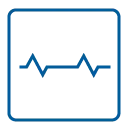


Multiple Replay
The Multiple Replay option allows the fast repetition output on several trigger events without restarting the hardware. With this option very fast repetition rates can be achieved. The on-board memory is divided in several segments of same size. Each of them is generated if a trigger event occurs.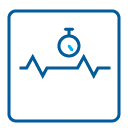
Timestamp
The timestamp option writes the time positions of the trigger events in an extra memory. The timestamps are relative to the start of recording, a defined zero time, externally synchronized to a radio clock, or a GPS receiver. With this option acquisitions of systems on different locations can be set in a precise time relation.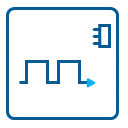
External Clock
Using a dedicated connector a sampling clock can be fed in from an external system. It's also possible to output the internally used sampling clock to synchronize external equipment to this clock.

High Precision PLL
The internal sampling clock of the card is generated using a high precision PLL. This powerful device allows to select the sampling rate with a fine step size making it possible to perfectly adopt to different measurement tasks. Most other cards on the market only allow the setup of fixed sampling rates like 100 MS/s, 50 MS/s, 25 MS/s, 10 MS/s, ... without any possibility to set the sampling rate to any value in between.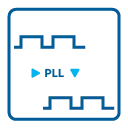
Reference Clock
The option to use a precise external reference clock (normally 10 MHz) is necessary to synchronize the board for high-quality measurements with external equipment (like a signal source). It's also possible to enhance the quality of the sampling clock in this way. The driver automatically generates the requested sampling clock from the fed in reference clock.
On-board Calibration
The on-board calibration can be run on user request and calibrates the amplifier against a dedicated internal high precision calibration source. After this calibration data is stored permanently in an on-board EEPROM and is automatically used for further acquisitions.

Programmable Input Amplifiers
The analog inputs can be adapted to real world signals using a wide variety of settings that are individual for each channel. By using software commands the input termination can be changed between 50 Ohm and 1 MOhm and one can select an input range matching the real world signal.
Programmable Input Offset
Most of the Spectrum A/D cards offer a user programmable signal offset opening the Spectrum boards to a wide variety of setups. The signal offset at least covers a range of +/-100 % of the currently selected input range making unipolar measurements with the card possible. Besides this the input range offset can be programmed individually allowing a perfect match of the A/D card section to the real world signal.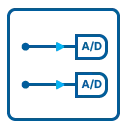
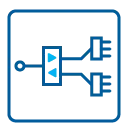
Multi Purpose I/O
All M4i cards offer three universal multi purpose I/O lines, which can be separately programmed as either input or output. When used as outputs, these lines can be used to output card status signals like trigger-armed or to output the trigger to synchronize external equipment.Programmable Output Levels
One of the key features of the M2i.72xx pattern generator series is the high number of different logic levels that can be programmed per board. The low and high output level of the pattern can be programmed in the range from -2V to +10V covering nearly all logic levels that are available like ECL, PECL, TTL, LVDS, LVTTL, CMOS or LVCMOS.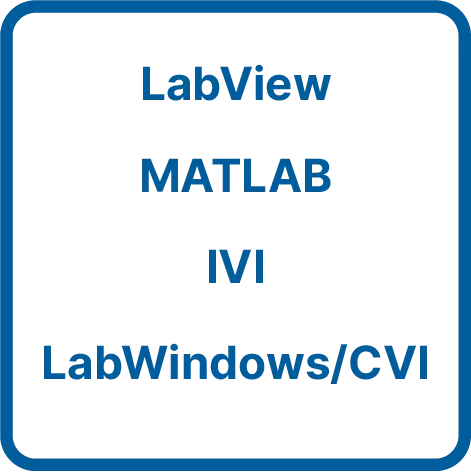

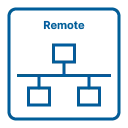
Remote Access
The digitizerNETBOX can be remotely accessed from any current Windows (starting with Windows XP) 32 bit or 64 bit system or Linux (starting with Kernel 2.6) 32 bit or 64 bit system by Ethernet. The remote access is done in the very exact programming like a locally installed product allowing to use any of the supported software packages.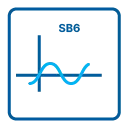
| Product | Channels | Max. Samplerate | Max. Bandwidth |
|---|---|---|---|
| DN2.822-02 | 2 | 250 MS/s | 125 MHz |
| DN2.822-04 | 4 | 250 MS/s | 125 MHz |
| DN2.825-02 | 2 | 500 MS/s | 250 MHz |
| DN2.825-04 | 4 | 500 MS/s | 250 MHz |
| DN2.827-02 | 2 | 180 MS/s | 125 MHz |
| DN2.827-04 | 4 | 180 MS/s | 125 MHz |
| DN2.828-02 | 2 | 400 MS/s | 250 MHz |
| On different platforms | Bus | Max. Bus Transfer speed |
|---|---|---|
| DN2.448-04 | Ethernet | 70 MByte/s |
| DN2.448-08 | Ethernet | 70 MByte/s |
| DN6.448-12 | Ethernet | 70 MByte/s |
| DN6.448-16 | Ethernet | 70 MByte/s |
| DN6.448-20 | Ethernet | 70 MByte/s |
| DN6.448-24 | Ethernet | 70 MByte/s |
| M4i.4481-x8 | PCI Express x8 | 3000 MByte/s |
| M4x.4481-x4 | PXI Express | 1700 MByte/s |

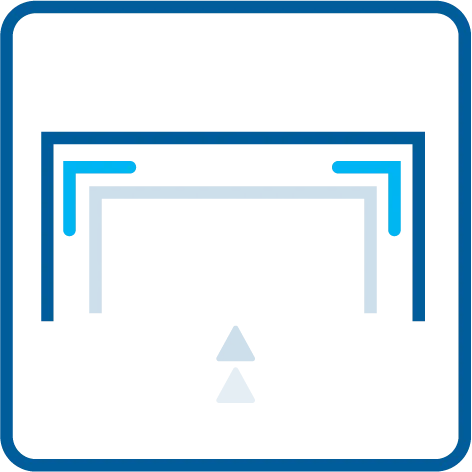
Documents
Data sheet of hybrdNETBOX DN2.82x |
08.03.2024 | 1 M | ||
Manual of hybridNETBOX DN2.82x family |
23.02.2024 | 13 M | ||
Short Manual for IVI Driver |
21.02.2022 | 532 K | ||
Data sheet of SBench 6 |
15.01.2024 | 999 K | ||
Manual for MATLAB driver M2p/M4i/M4x/M5i/M2i/M3i/DN2/DN6 |
13.12.2023 | 1 M | ||
Manual for LabVIEW drivers for M2i/DN2 |
21.02.2022 | 2 M | ||
Manual for SBench 6 |
21.02.2022 | 7 M |
WINDOWS DRIVER + SOFTWARE
M2p/M4i/M4x/M5i/M2i/M3i/DN2/DN6 driver for Windows 7, 8, 10, 11 (32/64 bit) |
7.01 | 22.04.2024 | 5 M | |
C/C++ driver header and library files |
7.01 | 22.04.2024 | 43 K | |
Spectrum Control Center (32-bit) / Windows 7, 8, 10 |
2.36 | 22.04.2024 | 22 M | |
Spectrum Control Center (64-bit) / Windows 7, 8, 10, 11 |
2.36 | 22.04.2024 | 25 M | |
Spectrum Control Center - last Version for Windows XP |
1.74 | 21.02.2022 | 8 M | |
SBench 6 (32-bit) Installer / Windows 7, 8, 10 |
6.5.08 | 22.04.2024 | 36 M | |
SBench 6 (64-bit) Installer / Windows 7, 8, 10, 11 |
6.5.08 | 22.04.2024 | 39 M | |
SBench6 - last Version for Windows XP |
6.3.5 | 21.02.2022 | 41 M | |
IVI Driver for IVI Digitizer class (32 bit) |
22.04.2024 | 3 M | ||
IVI Driver for IVI Scope class (32 bit) |
22.04.2024 | 3 M | ||
M2i/M2p/M3i/M4i/M4x/M5i/DN2/DN6 LabView driver installer |
22.04.2024 | 19 M | ||
M2p/M4i/M4x/M5i/M2i/M3i/DN2/DN6 Matlab driver + examples installer |
22.04.2024 | 15 M | ||
Windows Examples (C/C++, .NET, Delphi, Java, Python, Julia ...) |
7.01 | 22.04.2024 | 2 M |
LINUX DRIVER + SOFTWARE
Driver libraries (no Kernel) for Linux 32 bit and 64 bit |
7.01 | 22.04.2024 | 9 M | |
Spectrum Control Center |
2.36 | 22.04.2024 | 57 M | |
SBench 6 Linux 32 (.rpm) |
6.5.08 | 22.04.2024 | 26 M | |
SBench 6 Linux 64 (.rpm) |
6.5.08 | 22.04.2024 | 26 M | |
SBench 6 Linux 32 (.deb) |
6.5.08 | 22.04.2024 | 23 M | |
SBench 6 Linux 64 (.deb) |
6.5.08 | 22.04.2024 | 22 M | |
SBench6 Jetson (.deb) |
6.5.08 | 22.04.2024 | 11 M | |
Drivers + examples for MATLAB for Linux (DEB + RPM) |
22.04.2024 | 183 K | ||
Linux Examples (C/C++, Python, Julia ...) |
7.01 | 22.04.2024 | 560 K |
Firmware
DN2 Standard Firmware V27 (update from versions V7-V26 to V27) |
V27 | 21.02.2022 | 52 M | |
DN2 Standard Firmware V7 (update from versions V1-V6 to V7) |
V7 | 21.02.2022 | 11 M | |
DN2/DN6 Standard Firmware (install V27 first for updates prior to V27) |
V82 | 22.04.2024 | 34 M |
Product Notes
| Trigger and Sync | Trigger, Clock and Synchronization Details at high-speed Digitizers |
21.02.2022 | 1 M | |
| Digitizer Software Integration | Software Support for Modular Digitizers |
21.02.2022 | 724 K | |
| LXI based Digitizers | LXI based Multi-channel Digitizer Instrument |
21.02.2022 | 739 K | |
| SBench 6 Introduction | SBench 6 - Data Acquisition and Analysis of Digitizer Data |
21.02.2022 | 1 M |
Application Notes
| Teaming AWG with Digitizer | Teaming an Arbitrary Waveform Generator with a Modular Digitizer |
21.02.2022 | 919 K |

